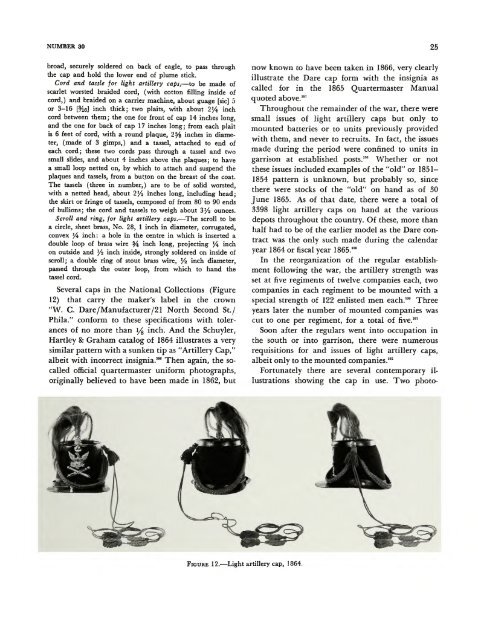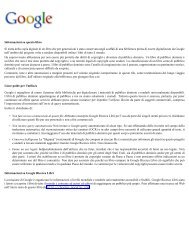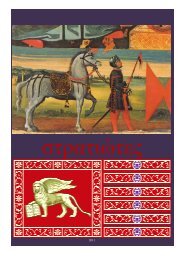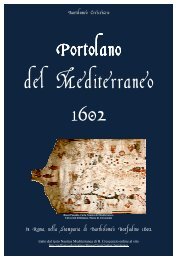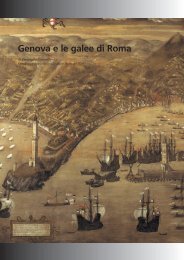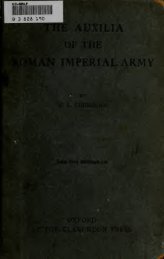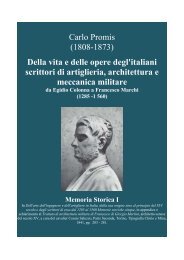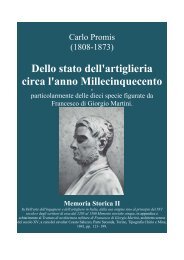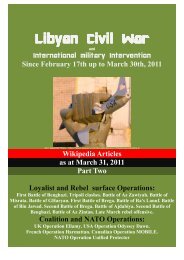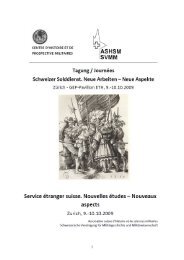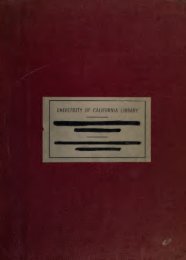24 SMITHSONIAN STUDIES IN HISTORY AND TECHNOLOGYing procedures, Crosman did not need authorizationfrom Washington to negotiate a contract for sosmall an amount."" Indeed, the letter books of theoffice of the Quartermaster General for 1863-1864indicate many issues of special type uniforms andequipment without stated or apparent authorizationfrom the top.'*" In any case, in April 1864,Meigs directed the issue of 1500 light artillery capswith all trimmings to the quartermaster at NewOrleans.'^' In June 1864, however, when Meigs wasmaking up his cost of clothing lists for publication,he very curtly asked Crosman why he had pricedHght artillery caps at $1.06 in 1863 and $2.89 in1864 and if the increase included the trimmings."'Crosman's complete reply is missing, and the Officeof the Quartermaster General's register of lettersreceived merely states, in reply to Meigs letter, theprice paid for light artillery caps "with explanations."""Whatever Crosman's "explanations" mayhave been, they must have been acceptable to Meigsfor nothing more of the matter appears in correspondencebetween the two and the cost of clothinglist published in July carried the light artillery capat $2.89 with the trimmings an additional $1.94.'"The origin of this cap form, which in general issimilar to the 1851-1854 pattern although quitedifferent in detail, is unknown and there is no hintgiven in the corresponence of the period. However,in an unpublished report of a board of officers establishedin 1862 to explore the possibility of auniform change is included: "Cap for Light ArtilleryOfficers—The cap ornaments and trimmings asnow worn in full dress, except that the cap shall beof the shape of model, deposited in Qr. M. Genls.Office. Trimmings and plume as now worn.'"'^Whether this is the pattern cap referred to in Crosman'scontract with Dare is of course unknown, butat least a pattern was available. The 1865 QuartermasterManual describes the cap and trimmings inminute detail.Uniform caps for light artillery—of 6 sizes; the following arethe specifications for caps. No. 3, medium size, viz: body ofcap made of stiffened felt, so as to preserve its form; madeon sample block, and covered with dark blue forage capcloth; diameter at the base, 7/2 inches; at the crown, 5^inches; covered at top with stiff glazed leather, of best quality,extending over the body % of an inch; sewed strongly at4 points,—front, rear, and sides, with 5 stitches each, anddepressed in the crown %c, of an inch; a band of thin glazedleather, best quality, 1 Ys inches wide encircling base; heightof cap in front, 5^ inches; in rear, curved, JYa inches;circular vizor of stiff glazed vizor leather, 11 Yl inches long,inside edge, and 19 inches on outside edge, breadth in themiddle, 2% inches, strongly sewed on body with 20 stitches;sweat leather of black morrocco of best quality % of aninch wide, sewed on exterior of base of cap, and folded inside;a small piece of morrocco, I/2 inches long and 1 inchwide, sewed inside of body of cap, l/a inches from the top,with ten stitches, leaving a loop to receive the whalebonestick of hair-plume; two chin straps of thin glazed leather,best quality, Ys inch wide, one of which to be 8 inches long,having sewed on one end a strong ^-inch buckle, of No. 19brass; at the other end a yellow vest button, with a piece ofNo. 18 iron wire, 2/2 inches long, looped in the eye of thebutton, with which to fasten the end of the strap to the cap,and having a glazed leather slide attached to strap, throughwhich to pass the end of the other strap after it has beenbuckled; the other chin strap of soft glazed leather, of samequality and width of short chin strap, and 12/2 incheslong, and having at one end 4 holes, punched at equal distances,to receive the tongue of buckle under the chin, and2 additional holes near the middle of strap, to receive thetongue of buckle when on the cap; the other end of thisstrap is fastened to the hat by a yellow vest button, withwire, similar in all respects to that described above for fasteningthe end of the other strap to hat.Brass crossed cannon,—stamped on a thin sheet of brass.No. 28, representing 2 cannon crossing each other at thetrunnions, muzzles upwards; length, 8/2 inches; breadth atbreech of cannon, Ys inch; breadth at muzzle, 5/2 inch providedwith 4 small brass wire loops, YB inch long, stronglysoldered on the back, to fasten them on hat.Brass bugles,—stamped on a thin sheet of brass. No. 28,length, 3 5/2 inches; height across a crook, 1Y2 inches; providedwith 2 iron wire loops, one of which is YB inch andthe other Yi inch long, strongly soldered on back of bugles,to fasten them on the hat.Horse-hair plume—of bright scarlet, fast color, length 15inches; circumference at the bast, where it is encircled bya brass ring, 3J4 inches; diameter of brass wire ring Ys inch;securely plaited and fastened for a distance of 4 inches ona square piece of whalebone, 8 inches long and Yi inchsquare; the plume to be secured at its lower end, around thewhalebone, by a. piece of red morrocco Yt inch wide, sewedaround it.Tulip, for horse-hair plume.—A thin sheet brass, No. 28,tulip of 4 leaves, strongly soldered to a shell and flame ofsame metal; length from bottom of shell to top of tulipleaf, 3^4 inches; length of tulip proper 2^ inches; diametermeasured across top of tulip leaves, 1 inch, opening at topto receive the plume; at bottom of tulip proper a roundopening, Y^ inch in diameter; a strong loop of brass wire,1-16 [Vio] inch diameter, % inch long, forming a rectangle,and strongly soldered to inside of shell, so as to pass throughthe cap and hold the tulip and plume.Ea'jle, for light artillery cap,—of thin sheet brass, No. 28,holding in left talon 3 arrows, and in dexter talon an oliveI)ranch, and with beak turned to the right; height, fromtalons to beak, 2 inches; breadth, from tip to tip of wings, 3inches; breadth, from arrow points to tip of olive branch, 2inches; a strong, brass wire loop Y2 inch long and Ys inch
NUMBER 30 26broad, securely soldered on back of eagle, to pass throughthe cap and hold the lower end of plume stick.Cord and tassle for light artillery caps,—to be made ofscarlet worsted braided cord, (with cotton filling inside ofcordj) and braided on a carrier machine, about guage [sic] 5or 3-16 [%6] inch thick; two plaits, with about 2}4 inchcord between them; the one for front of cap 14 inches long,and the one for back of cap 17 inches long; from each plaitis 6 feet of cord, with a round plaque, 2Ys inches in diameter,(made of 3 gimps,) and a tassel, attached to end ofeach cord; these two cords pass through a tassel and twosmall slides, and about 4 inches above the plaques; to havea small loop netted on, by which to attach and suspend theplaques and tassels, from a button on the breast of the coat.The tassels (three in number,) are to be of solid worsted,with a netted head, about 2/2 inches long, including head;the skirt or fringe of tassels, composed of from 80 to 90 endsof bullions; the cord and tassels to weigh about 3/2 ounces.Scroll and ring, for light artillery caps.—^The scroll to bea circle, sheet brass, No. 28, 1 inch in diameter, corrugated,convex J4 inch: a hole in the centre in which is inserted adouble loop of brass wire 54 inch long, projecting J4 inchon outside and 5/2 inch inside, strongly soldered on inside ofscroll; a double ring of stout brass wire, J/a inch diameter,passed through the outer loop, from which to hand thetassel cord.Several caps in the National Collections (Figure12) that carry the maker's label in the crown"W. C. Dare/Manufacturer/21 North Second St./Phila." conform to these specifications with tolerancesof no more than i/^ inch. And the Schuyler,Hartley & Graham catalog of 1864 illustrates a verysimilar pattern with a sunken tip as "Artillery Cap,"albeit with incorrect insignia.^*" Then again, the socalledofficial quartermaster uniform photographs,originally believed to have been made in 1862, butnow known to have been taken in 1866, very clearlyillustrate the Dare cap form with the insignia ascalled for in the 1865 Quartermaster Manualquoted above.'"Throughout the remainder of the war, there weresmall issues of light artillery caps but only tomounted batteries or to units previously providedwith them, and never to recruits. In fact, the issuesmade during the period were confined to units ingarrison at established posts."^ Whether or notthese issues included examples of the "old" or 1851-1854 pattern is unknown, but probably so, sincethere were stocks of the "old" on hand as of 30June 1865. As of that date, there were a total of3398 light artillery caps on hand at the variousdepots throughout the country. Of these, more thanhalf had to be of the earlier model as the Dare contractwas the only such made during the calendaryear 1864 or fiscal year 1865.'"°In the reorganization of the regular establishmentfollowing the war, the artillery strength wasset at five regiments of twelve companies each, twocompanies in each regiment to be mounted with aspecial strength of 122 enlisted men each.'"" Threeyears later the number of mounted companies wascut to one per regiment, for a total of five.'"Soon after the regulars went into occupation inthe south or into garrison, there were numerousrequisitions for and issues of light artillery caps,albeit only to the mounted companies.'*'Fortunately there are several contemporary illustrationsshowing the cap in use. Two photo-FiGURE 12.—Light artillery cap, 1864.
- Page 1: • ^ - :lP-'L^ry\'^ ^iT
- Page 4 and 5: ABSTRACTHowell, Edgar M. United Sta
- Page 7 and 8: ContentsPagePrefaceiiiThe 1855 Cava
- Page 9 and 10: United States Army Headgear 1855-19
- Page 11 and 12: NUMBER 30report, stated: "The hat p
- Page 13 and 14: NUMBER 30acorns %g inches long and
- Page 15 and 16: NUMBER 30the pattern." The rate of
- Page 17 and 18: NUMBER 30FIGURE 3.—1858 Army hat.
- Page 19 and 20: NUMBER 3011model, number 60 in the
- Page 21 and 22: NUMBER 30 13"the desired modificati
- Page 23 and 24: NUMBER 30 15the sun in the top. The
- Page 25 and 26: NUMBER 30 17FIGURE 8.—1858 forage
- Page 27 and 28: NUMBER 30 19Hardtack and Coffee, ca
- Page 29 and 30: NUMBER 3021FIGURE 11.—a, Brigadie
- Page 31: NUMBER 30 23short "shell" jacket "f
- Page 35 and 36: NUMBER 30 27worn in the picture wer
- Page 37 and 38: NUMBER 30 29This communication elic
- Page 39 and 40: NUMBER 30 31FIGURE 17.—"The [Scot
- Page 41 and 42: NUMBER 30 33time for issue in the c
- Page 43 and 44: NUMBER 30 35be at too great a dista
- Page 45 and 46: NUMBER 3037half (5/2) part of washb
- Page 47 and 48: NUMBER 30 39trimmings for all enlis
- Page 49 and 50: NUMBER 30 41ing the upper space for
- Page 51 and 52: NUMBER 30rear one to a correspondin
- Page 53 and 54: NUMBER 30 46FIGURE 29.—1872 enlis
- Page 55 and 56: NUMBER 3047FIGURE 32.—^The Bent &
- Page 57 and 58: NUMBER 3049of strong split-leather
- Page 59 and 60: NUMBER 30 51''""MttfenFIGURE 35.—
- Page 61 and 62: NUMBER 30 53(which he thought might
- Page 63 and 64: NUMBER 30 55FIGURE 38.—Captain Be
- Page 65 and 66: NUMBER 30 57campaign hat for the Ar
- Page 67 and 68: NUMBER 30 59salvage something from
- Page 69 and 70: NUMBER 30 61hat. In June 1899 the P
- Page 71 and 72: NUMBER 3063the left side, pass diag
- Page 73 and 74: NUMBER 30 65.LJU^.."*^..FIGURE 44.
- Page 75 and 76: NUMBER 30 67to be sent to Washingto
- Page 77 and 78: NUMBER 30 69with brass sliding-buck
- Page 79 and 80: NUMBER 30 71FIGURE 48.—Officers'
- Page 81 and 82: NUMBER 3073The adoption of the whit
- Page 83 and 84:
NUMBER 3075i >•^\Wiii I ifiiiniim
- Page 85 and 86:
NUMBER 30this last model made no pr
- Page 87 and 88:
NUMBER 30 79WAR DEPARTMENT,QUARTERM
- Page 89 and 90:
NUMBER 3081FIGURE 58.—1864 chapea
- Page 91 and 92:
NUMBER 30geon 1880 and Surgeon Gene
- Page 93 and 94:
NUMBER 3085FIGURE 63.—1895 forage
- Page 95 and 96:
NUMBER 30 87of not less than 9.24 g
- Page 97 and 98:
AppendixMAKERS OF HEADGEARThe chron
- Page 99 and 100:
List of AbbreviationsAAGAAQMAGAGOAQ
- Page 101 and 102:
NUMBER 3093all OQMG, LS, Clothing,
- Page 103 and 104:
NUMBER 30 95"Jesup to Thomas, 8 Dec
- Page 105 and 106:
NUMBER 3097OQMG, Reg. LR, Clothing,
- Page 107 and 108:
NUMBER 30 99October of 1870. See Me
- Page 109 and 110:
NUMBER 30 101'"* See above, pp. 35-
- Page 111 and 112:
NUMBER 30 103Monroe, Va., in 1878.
- Page 113 and 114:
NUMBER 30 105""Endorsement, 24 May
- Page 115 and 116:
ReferencesThe bulk of the source ma
- Page 117:
M MBIiR 30 10910, No. 355-10, 19 Se


